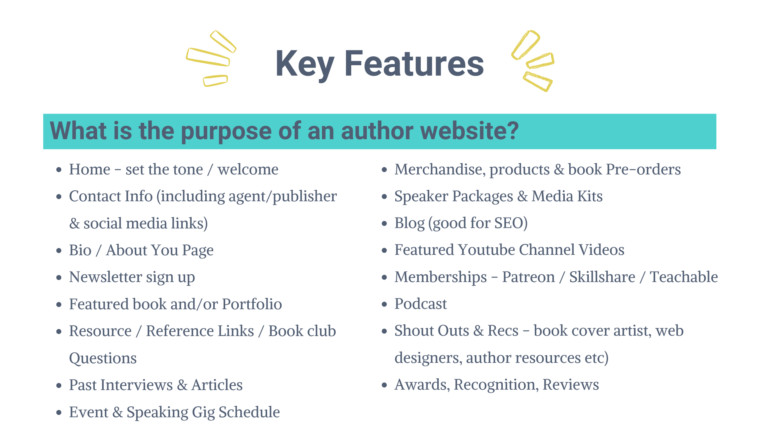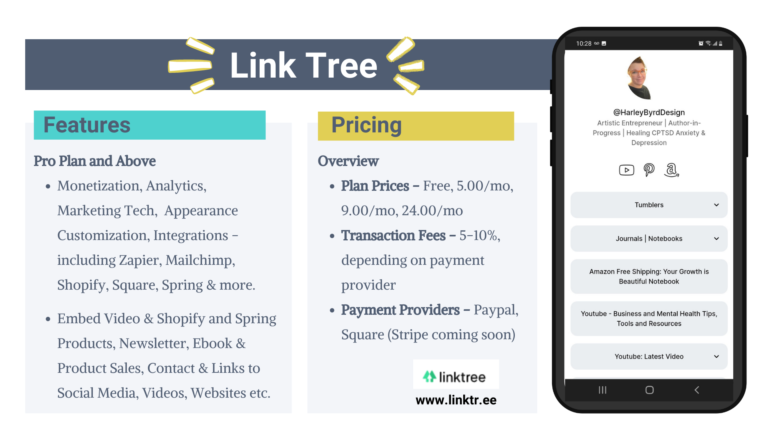In today’s video and article we’re going to look at how you can sell your book, planner, or journal online without creating a website. Before we get started, I want to clarify that this topic is not about downplaying the value of having your own website – it’s about spotlighting helpful platforms and tools as you explore all options. With that said, let’s get started so you can decide what’s right for you.
Subscribe
Click to watch the full video or scroll down to read the full article. Additional videos and resources are linked at the bottom of the page.
What are key features of a successful website?
First off, I want to recognize that some people may feel like creating a website is overwhelming, unnecessary and too expensive for their situation or current budget. With that in mind, this video will spotlight possible solutions that may meet some core needs without requiring the extra time, money and energy that may not be currently available.
Before we look at how to sell a book or product without a website, we’ll look at the website features that could be of use to you. You might consider pausing to identify which website features and functionalities listed here would likely be useful for you. Doing this may help you see if the following platforms and tools will satisfy those needs. If there are features that you’re looking for that are not listed here you might note those as well. In this example, we’ll focus on key features of a successful Author website; having said that, many of these features are key for other websites as well.

This first list are website features that were commonly recommended by other authors. The second list are some possible additions that came to my mind. These aren’t exhaustive lists but they do provide some solid basic ideas.
Landing Pages
We’re going to look at a 3 platforms that have many of the functionalities that websites provide – including analytics, the ability to sell products and services, and options to integrate with other tools like mailchimp, zapier, and more.
We’ll start off by looking at Link Tree so you can see some of the features and functionalities that a landing page can provide. Basically, Link Tree pages are both a “Launch Page” and a “Directory Page” all-in-one.
Here is a basic example of a link tree page – both the mobile view and desk top view. You can see a brief description, key links to different platforms and featured links to products as well.

Link Tree also connects / integrates with Shopify and Spring.

You can create a mini contact page as well, which can be quite useful.

You can accept donations directly from your Link Tree page as well.

And you can insert a URL link to other platforms, websites and resources as well – including Amazon listings, Youtube videos and Etsy products.

The appearance is customizable – the font, color scheme, and other elements can be changed.


Link Tree integrates with Zapier, Mailchimp and the Analytics provide a good perspective of your traffic flow. You can incorporate pixel ids, tiktok ids and google ids to help see where your traffic is coming from.
Now that you know what a Landing Page provides and how they function – let’s look at a basic overview of at least three popular platforms so you can compare them at a glance:



Marketplace Platforms
There are several marketplace platforms that you can sell products from. If you want to avoid building a website like Shopify – using a marketplace platform in conjunction with a landing page and a healthy social media presence may be worth considering.
AMAZON KDP
Amazon’s KDP allows you to publish and sell your books, planners and journals from Amazon’s website. There are major advantages to this, including free shipping for prime customers. Of course there are drawbacks, too – If you want more information on the pros and cons of KDP check out the “Amazon KDP vs Lulu Xpress” video on our youtube channel.
This is a listing I recently created for a journal so we can see an example of what that could look like.

The basic premise here is that you could self-publish your book, planner or Journal through KDP, create a listing and then drive traffic to that listing to generate sales. You can link to this listing from other platforms, like Link Tree and Youtube, which can help drive traffic to your listing as well.
It is pretty easy to get started and there is no upfront cost – you pay royalties to amazon only at the time a purchase is made – here is KDP’s informational page that will help walk you through the process: https://kdp.amazon.com/en_US/
ETSY
The second platform that we’ll take a look at today is Etsy. This is a listing I just created in an empty etsy shop just so you can see what it looks like to sell a print on demand product via Etsy.

You can sell print on demand products like journals and planners via Etsy by connecting your Etsy shop to a print on demand fulfillment company, like printify, for example. Connecting with Etsy is very easy and can be initiated from the printify website.

Basically, you create a printify account, select a product, design it and save it. Then you connect your saved product to your etsy shop. When a customer places an order Printify produces the product and ships it to the customer.
With that said, Printify is not a path for printing and selling books. If you wanted to sell your book on Etsy you could purchase a small inventory of your book via Lulu and then send it to your customers when orders come through on Etsy. Another method I have heard people mention is that when an order comes through on Etsy they order the book on lulu.com and have the book shipped directly to the customer. I have also heard of people using the Shopify lite plan as a conduit to connect Esty to Lulu Direct App, which allows them to sell their books print on demand. I have not used these methods myself so I cannot confirm how well they work, but they may be worth looking into if you are looking for a creative solution to sell your book through Etsy.
Here is an example of an Etsy shop owner who sells her own books – just so you can see what that might look like – customers can select the book title from the drop down shown here.

If your also an artist selling from Etsy may be appealing as it would allow you to sell journals and books alongside your artistic creations.
Amazon and Etsy are not the only platforms you could sell from, but I wanted to focus on them in this blog post because they are popular and tend to come up when discussing marketplace platforms.
Having said that, Etsy comes with a whole host of requirements and best practices. It might look like a simple platform, and in some ways it is – but there are a lot of details to consider if you are going to build a successful Etsy shop that also meets Etsy’s guidelines – which can be extensive. I will link to an overview of the pros and cons of Etsy in the Links & Resources section of this blog post in case your interested in exploring this option further.
And on that note, there are clear advantages as well as downsides of using KDP as well – check out this youtube video Amazon KDP vs Lulu Xpress for a more in-depth perspective.
I do want to point out that one of the major advantages of selling via marketplace platforms is that you do not have to manage sales tax like you would if you were selling your products via your own website. I’m not a sales tax expert so I won’t get into the details here but it is something to consider when weighing your options and identifying what might be right for you.
Google Sites
There are a variety of features that websites can provide – like author pages, an active list of the books, and articles that you’ve published and marketing graphics for featured products and books. Although building a full on website may be overwhelming, creating a collection of basic and simple web pages on a free google site could be much simpler for you and also help you provide important content to potential readers and customers. Let’s take a look at an example google site highlighted by www.sitebuilderreport.com:

www.googledrawings.org/home

www.googledrawings.org/resources

www.googledrawings.org/process
Google sites can be simple to create – as shown in the example above, this site is compromised mostly of images, links and simple text. And because Google Sites are a no cost feature that comes with free Gmail accounts they are free to create. To see examples of other Google sites and how easy they can be to build, check out the Youtube video: How to Sell Online Without a Website, beginning at this clip: 18:43 Google Sites.
Other Possibilities
I have not used these sites myself, but they are recommended by other youtube content creators and may be worth considering.

The majority of these sites allow you to create a blog that allows you to use your own domain name – there are other advantages and drawbacks, but if your main concern here is creating awareness and driving traffic to yourself as an author, or a subject matter expert – one or more of these platforms might be of use to you.
ELFSIGHT
Elfsight.com is also a tool that may of use to you. It allows you to Embed Reviews, Videos, Forms, Tools and content from social media into your website. Integrates with Google Sites, Shopify, Blogger, Ghost, Tumblr, Kajabi, Squarespace, Wix and more. Plans range from free to 75/mo. Check out elfsight.com to learn more.

ZAPIER
For those of you who are not familiar with Zapier – it is a tool that allows you to streamline and automate processes between platforms. In other words, Zapier allows you to connect a platform like Stan with Youtube, or Zoom, or Calendly. In practical terms, if someone purchased a course or e-book, zapier could automatically email them a series of pre-written communications and information. Or if someone filled out a survey, zapier could transfer all of the survey results to a google spreadsheet. Zapier automates and streamlines processes so you can focus on doing other things. Here are just some of the platforms that integrate with Zapier.

FIVERR
As you may already know, you can find experts in a wide variety of subjects on Fiverr. You can also receive support on building an Etsy shop, Link Tree page, Shopify site and Google site.

Something to Consider..
Having a fully functional website, from the get go, is a valuable consideration, which is why they are so commonly recommended. However their power and effectiveness rely tremendously on well they are built.
websites are often recommended For good reason
As you can see from the features shown below – websites are a major tool and you can build a valuable online presence by marketing your book or products and continually linking back to the same place – your website. Over time all of this effort can create real concentrated value and help prevent confusion and scattered traffic. You can expand the items that you sell without having to direct people to another platform – for example, today you may be starting with a book but over time you might sell other merchandise that compliments your brand, expertise or writing genre. You can feature and link to podcasts that you were a guest on, events that you will be speaking at and/or are sponsoring. You can point to resources that might be of help to your community – the opportunities are, in a way, endless. And, with that said, the time, money and work associated with websites can feel endless too.

So – to be clear – websites can be a powerful tool, but, as we’ve seen today, there are a variety of tools and platforms that may be helpful as you get started.
Creative Solutions May Help You get started
Many of the options shown may compliment each other and meet your core needs – they may also continue to be beneficial when/if you choose to create a website. You could also immediately benefit from some of the platforms shown here AND also create and customize your own website on your own timeline. We all have different needs and circumstances – and I have seen some people generate income with a strong social media presence, on Tik Tok for example, and a landing page, like the ones shown in this video / blog. Other people will need and benefit most from a fully functional website.
Links & Resources
FEATURED LANDING PAGES
https://www.beacons.ai
https://www.linktr.ee
https://www.stan.withme
Stan Page Examples
Featured Marketplaces
Example Google Sites
Additional Resources
thank You
Thank you for reading this article! Feel free to subscribe and check out other videos on our youtube channel.
Subscribe
Share this article:
————-
Affiliate Disclosure: This video description and/or blog may contain affiliate links, which means that if you click on one of the product links, I’ll receive a small commission. I won’t recommend anything that I haven’t verified or personally used myself.
Harley Byrd Design, LLC Disclaimer: The information provided in or through our Websites, Programs, Events, Videos, Tutorials and Services is for educational and informational purposes only and is made available to you as self-help tools for your own use. When using any material obtained from or through Harley Byrd Design, LLC, whether through in-person, webinars, social media, youtube, and otherwise in a variety of settings, including but not limited to individual and/or group programs, classes, workshops, events, tutorials, videos, seminars, consultations and/or trainings, you acknowledge that we are supporting you in our role exclusively as providing information, and in no other role. Additionally, the perspectives shared are based on my own experiences and do not represent any other person or entity. Recommendations provided should not be used in lei of or substituted for your own judgement and/or for advice by a business expert or medical professional.